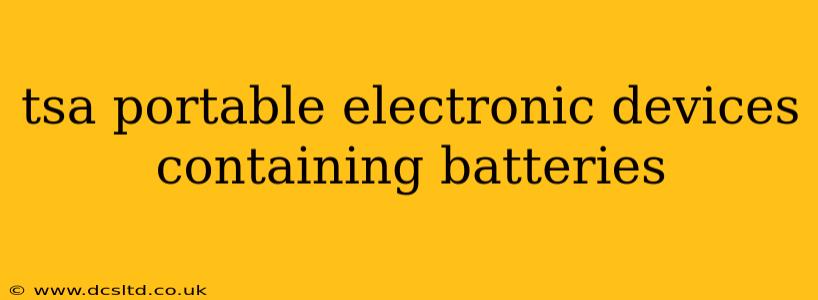Traveling with portable electronic devices can be stressful, especially when navigating Transportation Security Administration (TSA) regulations. Understanding the rules surrounding batteries in these devices is crucial for a smooth and efficient airport experience. This guide will clarify TSA guidelines, address common concerns, and help you pack your electronics confidently.
What Electronic Devices are Subject to TSA Battery Rules?
This covers a wide range of devices, including but not limited to:
- Smartphones: iPhones, Android phones, etc.
- Laptops: Notebooks, ultrabooks, Chromebooks.
- Tablets: iPads, Android tablets, etc.
- E-readers: Kindles, Kobo e-readers.
- Cameras: Digital cameras, camcorders.
- Portable gaming devices: Nintendo Switch, PlayStation Vita.
- Power banks: Portable chargers.
- Bluetooth devices: Headphones, speakers.
- Medical devices: CPAP machines, insulin pumps (requiring special procedures, see below).
Can I Pack Batteries in My Checked Baggage?
Generally, spare batteries should be carried in your carry-on bag, not checked baggage. This is because loose batteries in checked bags can short-circuit and potentially cause a fire. However, devices containing batteries are permitted in checked bags, provided they are properly protected to prevent accidental activation. Always ensure devices are turned off and adequately protected within a case or bag.
What are the Rules for Lithium-ion Batteries?
Lithium-ion batteries power most of our portable electronics. The TSA has specific regulations for these:
- Spare batteries: Should be individually protected to prevent short circuits. This usually means insulating the terminals with tape or placing them in their original packaging.
- Installed batteries: Devices containing lithium-ion batteries are allowed in carry-on and checked baggage, but as mentioned, spare batteries should generally be carried on.
What about Lithium Metal Batteries?
Lithium metal batteries are less common in portable electronics but are still important to consider. The rules are more restrictive:
- Spare batteries: Lithium metal batteries with a watt-hour rating of more than 2 grams are generally prohibited in both carry-on and checked baggage. Exceptions may exist for medical devices—always check with the TSA beforehand.
- Installed batteries: Devices containing lithium metal batteries may be allowed in carry-on and checked baggage, depending on the device and the battery's characteristics. Consult the TSA website for the most up-to-date information.
How do I Pack My Electronics for TSA Screening?
To ensure a smooth screening process:
- Keep them accessible: Place your electronics in a separate bin for X-ray screening. This speeds up the process and avoids unnecessary delays.
- Power them down: Turn off all electronic devices before placing them in the bin.
- Remove them from protective cases: While it's good to have protective cases, it's often necessary to remove electronics from these for easier screening. This is particularly important if the case is thick or made from a metallic material.
What if I Have a Medical Device with a Battery?
Passengers with medical devices powered by batteries should contact the TSA Cares helpline at least 72 hours before their flight. This allows for pre-screening and coordination to ensure a seamless process. They will provide guidance on how to properly declare and transport your medical equipment and batteries.
What Happens if My Battery is Damaged or Leaking?
If you discover a damaged or leaking battery, do not attempt to transport it. Contact the airline or airport security immediately for guidance on proper disposal.
Where Can I Find the Most Up-to-Date Information?
The official TSA website is the most reliable source of information on carrying electronics and batteries through airport security. Their website is frequently updated, and checking it before your trip is highly recommended.
By following these guidelines and remaining informed, you can navigate TSA security checkpoints efficiently and without incident, ensuring a stress-free travel experience. Remember, safety is paramount, and adhering to regulations contributes to a secure environment for everyone.
